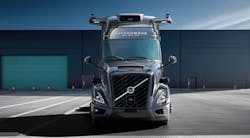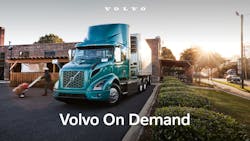Volvo Unveils Autonomous Truck and Electric On Demand Service
Volvo Group North America has unveiled the Volvo VNL Autonomous, its first-ever production-ready autonomous truck, as well as Volvo on Demand, a Truck-as-a-Service (TaaS) initiative using 25 Class 8 Volvo VNR Electric trucks to accelerate battery electric vehicle adoption.
The Volvo VNL Autonomous, borne from a collaboration between Volvo Autonomous Solutions (V.A.S.) and Aurora Innovation, integrated the Volvo VNL Autonomous and the Aurora Driver, an SAE L4 autonomous driving system. The Aurora Driver consists of AI software, dual computers, proprietary lidar that can detect objects more than 400 meters away, high-resolution cameras, imaging radar, and additional sensors.
The announcement came during the 2024 ACT Expo. See other ACT news here.
The Aurora Driver has been trained and tested in Aurora’s virtual suite where it’s driven billions of miles. It also has driven 1.5 million commercial miles on public roads, where it navigates end-to-end trucking routes traversing highways, rural roadways, and surface streets day and night and through good and bad weather.
“Our platform engineering approach prioritizes safety by incorporating high-assurance redundancy systems designed to mitigate potential emergency situations,” said Shahrukh Kazmi, CPO Volvo Autonomous Solutions, in a statement. “We built the Volvo VNL Autonomous from the ground up, integrating these redundancy systems to ensure that every safety-critical component is intentionally duplicated.”
The platform-based design approach will enable Volvo to use its in-house developed virtual driver for trucks and machines working within confined applications and partner virtual driving technologies for on-highway trucking applications.
The Volvo VNL Autonomous therefore has redundant steering, braking, communication, computation, power management, energy storage and vehicle motion management systems.
Volvo on Demand
Volvo Trucks North America (VTNA) and Volvo Financial Services (VFS) are using 25 Class 8 Volvo VNR Electric trucks to launch Volvo on Demand, the company's take on the TaaS business model "to simplify the acquisition and reduce the major upfront investment in battery-electric vehicles" it says.
The program provides qualified customers with term options ranging 12 months and up, and includes Volvo Trucks’ Gold Contract and the option to bundle vehicle insurance for physical damage and collision, route planning and optimization guidance, as well as consultation to find charging solution and incentives that might be available.
Want the latest on electric and autonomous vehicle adoption?
The program provides qualified customers with term options ranging 12 months and up, and includes Volvo Trucks’ Gold Contract and the option to bundle vehicle insurance for physical damage and collision, route planning and optimization guidance, as well as consultation to find charging solution and incentives that might be available.
The Class 8 Volvo VNR Electric is a zero-tailpipe emission solution that has a range of up to 275 miles with a six-battery configuration and features a dedicated battery thermal management system to maintain ideal battery temperatures. With a 250 kWh charge rate, the truck can achieve an 80% charge in 90 minutes for the six-battery package and 60 minutes for the four-battery package.
“Volvo on Demand is the easiest way for customers to add a battery-electric truck to their fleet by providing the ability to test the technology and understand the requirements to operate an electric fleet without a substantial upfront investment,” said Charles Carter, VP, services and solutions, in a staement. “Volvo on Demand offers peace of mind to customers who are just beginning their electromobility journey, managing the unknowns and uncertainties of how to best run and scale electric trucks in their operations."
Volvo on Demand is being launched in the United States in areas with a nearby Volvo Trucks Certified Electric Vehicle (EV) dealership equipped to provide comprehensive support, including preventative maintenance, service, and charging facilities to maximize customer uptime.
About the Author
Harlee Hewitt
Harlee is a former associate editor for Construction Equipment.

